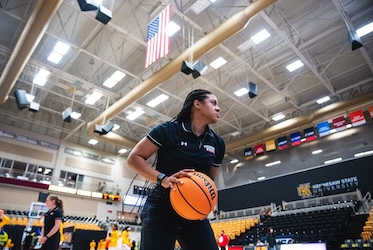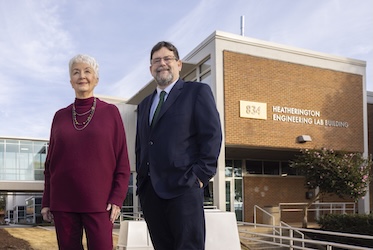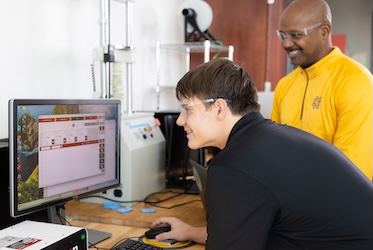

KENNESAW, Ga. | Oct 26, 2018
Engineering students battle for air supremacy in annual Pumpkin Launch
Beneath cloudy skies on Kennesaw State University’s Marietta Campus, precipitation took the form of 8-pound pumpkins raining down on a grassy field as first-year mechanical engineering students put their skills to the test in the annual Pumpkin Launch.
The launch, now in its eighth year, is the culmination of a semester-long project for students in the Introduction to Mechanical Engineering course offered by the Southern Polytechnic College of Engineering and Engineering Technology. The pumpkin-launching traces its roots back to the former Southern Polytechnic State University, which sought ways to develop an interesting experience for first-year students while helping student retention, and has since grown to become a staple event on the Marietta Campus.
“This is really a great introduction into engineering and design,” said David Veazie, professor of mechanical engineering. “Now, it involves about 250 students, all of whom are learning the basics of projectile motion, stress analysis and group dynamics, among so many others. All of these are skills they will need throughout their time here at Kennesaw State and in their careers as professionals.”

For the first time, the event was held at the newly-renovated Marietta Multipurpose Fields on Koger Drive, allowing more room than ever for pumpkins to fly. Under competition rules, launchers had to be “purely mechanical,” meaning they could not use chemical propellants or electrical power. Devices included trebuchets, catapults, ballistas and slingshots, and had to fit into a designated space, typically 8 feet long by 8 feet wide, with a maximum counterweight of 750 pounds. Each team was allowed three attempts to launch a pumpkin, and awards were given for distance, accuracy and pumpkin decoration.
The phrase “third time’s a charm” rang especially true for student Isaac Wasson and his team, Raiders of the Lost Pumpkin, as they earned the distance trophy on their final shot of the day. Using a traditional trebuchet loaded with more than 700 pounds of barbell weights, the team successfully lobbed pumpkins well over 100 feet in their first two attempts but still chased the long distance mark of 156 feet set by their closest competitor, Monty Pumpkin. After making adjustments to their release angle, the team heaped on more weight for their third and final run. Once given the go-ahead, Wasson yanked the firing pin and stepped back to watch the pumpkin soar 194 feet.
“Really, it was a huge risk to make those adjustments on the last run but I’m relieved that it paid off in the end,” he said. “It’s really easy to do a simple calculation and run simulations on how far you think a trebuchet can toss a pumpkin, but when you start to actually build the machine, there are so many other variables that we didn’t prepare for given our level of experience.”
Though his team fell short of the distance trophy, Monty Pumpkin’s Michael Estes said the experience of conceptualizing and building a trebuchet with his teammates has been a fun application of his studies this semester. As is the case each year, teams are subject to a critical design review weeks before the Pumpkin Launch, which culminates in a classroom presentation in which they defend the merits of their design and the research that went into its selection.
Like Wasson, Estes’ team chose to build a traditional trebuchet but used a concrete-filled V8 engine from a Ford F150 as their counterweight. The team gave its device a theoretical launch distance of at least 50 meters, or 164 feet.
“The biggest challenge is getting the physics down,” Estes said. “From the little details of how the pumpkin releases from the sling, to how much weight you need on the throwing arm, there are a lot of little things that affect how well your machine performs.”

After an initial launch that flew skyward rather than down range, Pumpkémon, led by captain Taylor Jones, immediately grabbed a power drill and began making adjustments to their launcher. His team opted for a more unique design by building a whipper trebuchet, which places the counterweight at the top of the device and points the arm downrange rather than backward like other devices.
“Our throwing arm is shorter, which enables it to rotate almost 360 degrees before it releases and gives the pumpkin a lot more time to accelerate,” Jones said. “From everything we saw in our research, using the same amount of weight on whipper trebuchet would throw a pumpkin farther.”
Though his team didn’t pass Raiders of the Lost Pumpkin for distance, it did take home the accuracy award given to the team with the most launches near 30 meters, or about 98 feet. Another team, Pumpkin Slaughter, won the pumpkin decoration portion of the event.
“This has been super eye-opening,” Jones said. “I think it’s hard to appreciate how to work through problems without going through something like this. Even estimating how far we’re going to launch and how we’re going to engineer things shows us how many pieces of the engineering puzzle we’re going to need to learn down the road.”
The Southern Polytechnic College of Engineering and Engineering Technology at Kennesaw State University is the second largest engineering college in Georgia, serving more than 4,000 students. The College offers 20 undergraduate and graduate degrees in engineering and engineering technology led by industry-expert faculty in the university’s state-of-the-art facilities.
— Travis Highfield
Photos by Lauren Kress


Former SGA president thrives in player development role for Georgia State women's hoops

Lawrence Whitman installed as Dale and Ann Heatherington Endowed Chair of Engineering and Engineering Technology

Rising above challenges marks inspiring career of President's Award of Distinction recipient

Kennesaw State team innovates stronger 3D-printed structures through advanced simulations
A leader in innovative teaching and learning, Kennesaw State University offers undergraduate, graduate, and doctoral degrees to its more than 51,000 students. Kennesaw State is a member of the University System of Georgia with 11 academic colleges. The university's vibrant campus culture, diverse population, strong global ties, and entrepreneurial spirit draw students from throughout the country and the world. Kennesaw State is a Carnegie-designated doctoral research institution (R2), placing it among an elite group of only 8 percent of U.S. colleges and universities with an R1 or R2 status. For more information, visit kennesaw.edu.